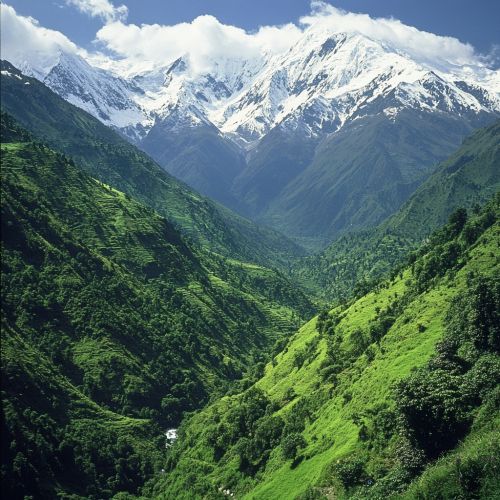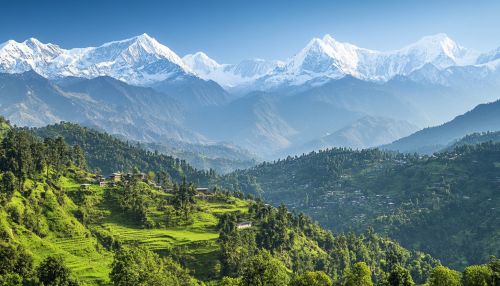Conservation Efforts in the Himalayas: Difference between revisions
(Created page with "== Introduction == The Himalayas, a majestic mountain range in Asia, is home to some of the world's most diverse ecosystems. Spanning five countries—Bhutan, China, India, Nepal, and Pakistan—the region is a biodiversity hotspot. However, it faces numerous environmental challenges, necessitating extensive conservation efforts. This article delves into the various conservation initiatives undertaken in the Himalayas, exploring their methodologies, successes, and ongoin...") |
No edit summary |
||
| Line 12: | Line 12: | ||
One of the primary conservation strategies in the Himalayas is the establishment of protected areas and national parks. Notable examples include [[Sagarmatha National Park|Sagarmatha National Park]] in Nepal, [[Great Himalayan National Park|Great Himalayan National Park]] in India, and [[Jigme Dorji National Park|Jigme Dorji National Park]] in Bhutan. These areas provide safe havens for wildlife and help preserve critical habitats. | One of the primary conservation strategies in the Himalayas is the establishment of protected areas and national parks. Notable examples include [[Sagarmatha National Park|Sagarmatha National Park]] in Nepal, [[Great Himalayan National Park|Great Himalayan National Park]] in India, and [[Jigme Dorji National Park|Jigme Dorji National Park]] in Bhutan. These areas provide safe havens for wildlife and help preserve critical habitats. | ||
[[Image:Detail-98101.jpg|thumb|center|Scenic view of the Himalayan landscape with snow-capped peaks and lush green valleys.|class=only_on_mobile]] | |||
[[Image:Detail-98102.jpg|thumb|center|Scenic view of the Himalayan landscape with snow-capped peaks and lush green valleys.|class=only_on_desktop]] | |||
=== Community-Based Conservation === | === Community-Based Conservation === | ||
Latest revision as of 21:23, 24 September 2024
Introduction
The Himalayas, a majestic mountain range in Asia, is home to some of the world's most diverse ecosystems. Spanning five countries—Bhutan, China, India, Nepal, and Pakistan—the region is a biodiversity hotspot. However, it faces numerous environmental challenges, necessitating extensive conservation efforts. This article delves into the various conservation initiatives undertaken in the Himalayas, exploring their methodologies, successes, and ongoing challenges.
Biodiversity in the Himalayas
The Himalayas are renowned for their biodiversity, hosting a wide array of flora and fauna. The region is home to over 10,000 plant species, 300 mammal species, 977 bird species, and numerous reptiles, amphibians, and insects. Key species include the snow leopard, red panda, and Himalayan monal. The diverse ecosystems range from tropical forests at lower altitudes to alpine meadows and glaciers at higher elevations.
Threats to the Himalayan Ecosystem
Several factors threaten the Himalayan ecosystem, including climate change, deforestation, overgrazing, and human encroachment. Climate change has led to glacial retreat, altering water availability and affecting both human and wildlife populations. Deforestation for agriculture and urbanization disrupts habitats, while overgrazing by livestock leads to soil erosion and loss of plant species.
Conservation Strategies
Protected Areas and National Parks
One of the primary conservation strategies in the Himalayas is the establishment of protected areas and national parks. Notable examples include Sagarmatha National Park in Nepal, Great Himalayan National Park in India, and Jigme Dorji National Park in Bhutan. These areas provide safe havens for wildlife and help preserve critical habitats.


Community-Based Conservation
Community-based conservation involves local communities in the management and protection of natural resources. This approach has been particularly successful in the Himalayas, where indigenous knowledge and practices play a crucial role. Programs like the Annapurna Conservation Area Project in Nepal empower local communities to manage their resources sustainably, balancing conservation with livelihood needs.
Anti-Poaching Initiatives
Poaching poses a significant threat to many Himalayan species, particularly the snow leopard and red panda. Anti-poaching initiatives, such as increased patrolling, the use of technology like camera traps, and community vigilance programs, have been implemented to combat this issue. Organizations like the Snow Leopard Trust work closely with local communities to reduce poaching incidents.
Climate Change Mitigation
Glacial Monitoring
Glacial retreat is one of the most visible impacts of climate change in the Himalayas. Monitoring programs, such as those conducted by the International Centre for Integrated Mountain Development (ICIMOD), track glacial changes and provide data crucial for water resource management and disaster preparedness.
Reforestation and Afforestation
Reforestation and afforestation projects aim to restore degraded lands and enhance carbon sequestration. Initiatives like the Green India Mission focus on planting native tree species, which help stabilize soil, improve water retention, and provide habitat for wildlife.
International Cooperation
The transboundary nature of the Himalayas necessitates international cooperation for effective conservation. Initiatives like the Kangchenjunga Landscape Conservation and Development Initiative promote cross-border collaboration among Bhutan, India, and Nepal. These efforts facilitate the sharing of knowledge, resources, and strategies to address common conservation challenges.
Challenges and Future Directions
Despite significant progress, conservation efforts in the Himalayas face ongoing challenges. These include limited funding, political instability, and the need for greater community involvement. Future directions for conservation in the region include enhancing scientific research, increasing international cooperation, and integrating traditional knowledge with modern conservation practices.
See Also
- Biodiversity
- Climate Change
- Snow Leopard Trust
- International Centre for Integrated Mountain Development
- Green India Mission
